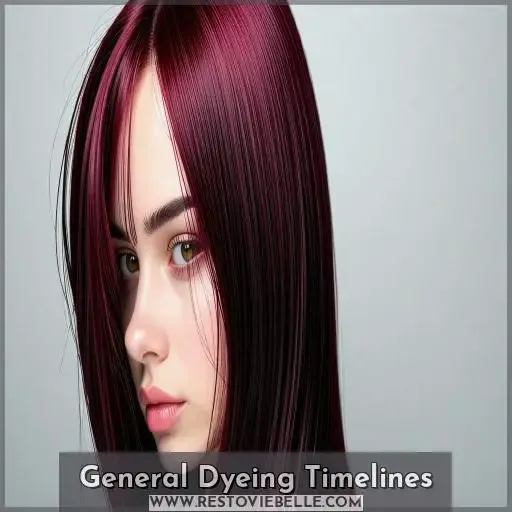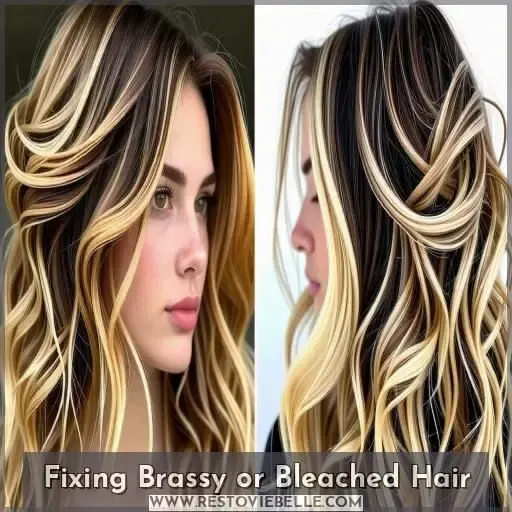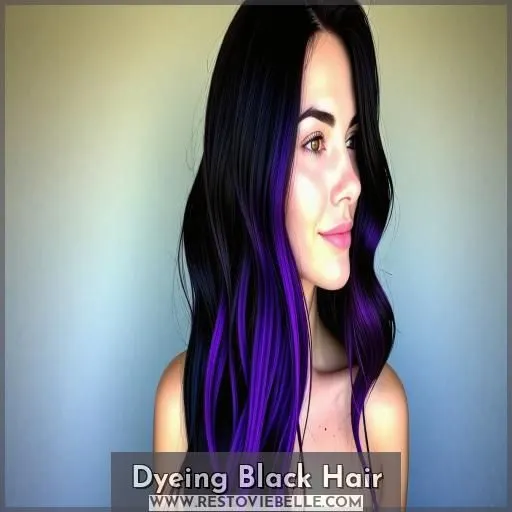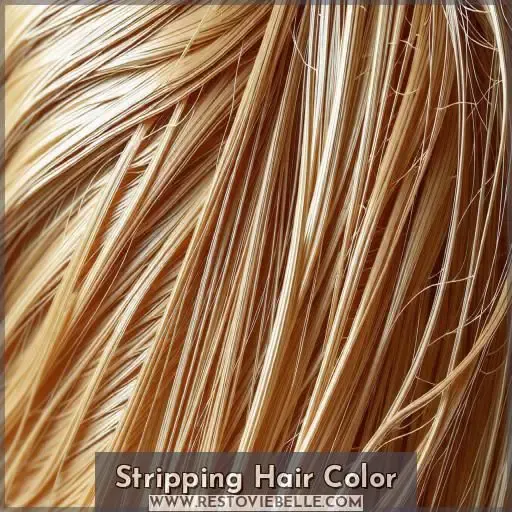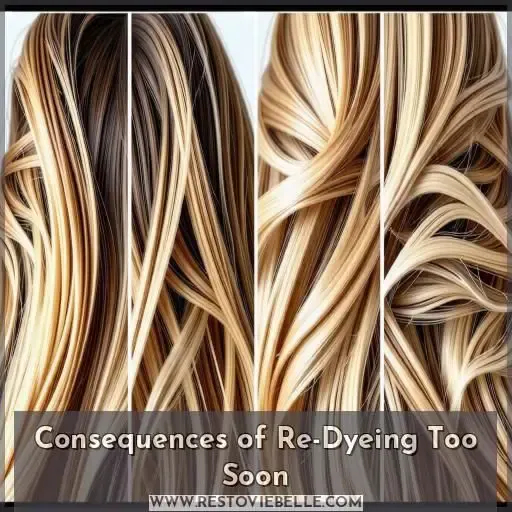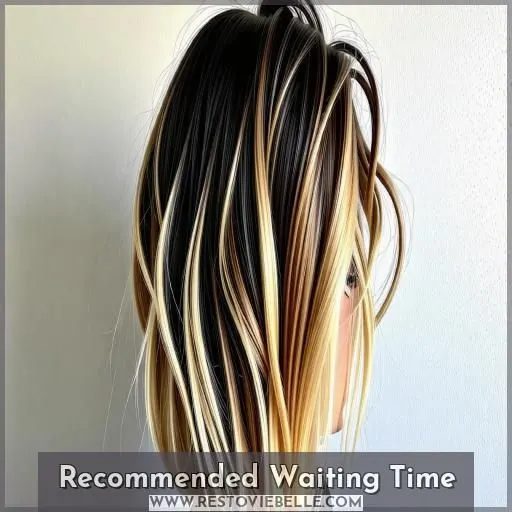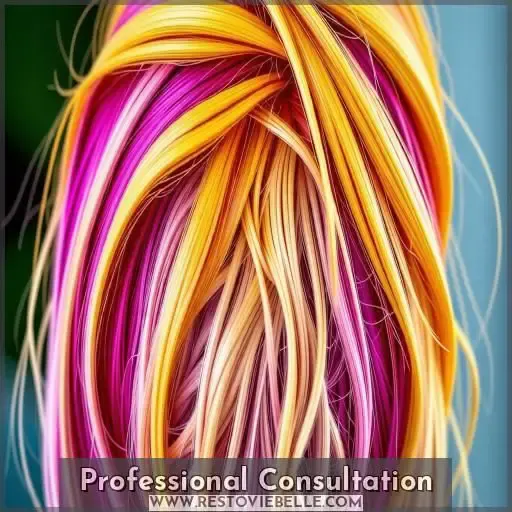This site is supported by our readers. We may earn a commission, at no cost to you, if you purchase through links.
 You should wait at least 4 weeks before re-dyeing your hair again to avoid causing irreversible damage.
You should wait at least 4 weeks before re-dyeing your hair again to avoid causing irreversible damage.
Dyeing too frequently can permanently ruin your hair’s cuticle, leaving it dry, frizzy, and prone to breakage.
Semi-permanent dyes offer quicker refreshes, but permanent color needs ample recovery time.
Your natural hair color and previous processing also impact timelines – black hair often requires bleaching first.
Play it safe by consulting a professional stylist – they’ll recommend the ideal schedule to keep your locks looking luscious.
Table Of Contents
- Key Takeaways
- How Long Should You Wait Before Dyeing Your Hair Again?
- General Dyeing Timelines
- Fixing Brassy or Bleached Hair
- Dyeing Black Hair
- Stripping Hair Color
- Consequences of Re-Dyeing Too Soon
- Recommended Waiting Time
- Factors to Consider
- Professional Consultation
- Frequently Asked Questions (FAQs)
- How soon can I dye my hair again to fix it?
- How soon can I recolor my hair if I don’t like the color?
- Can I re-dye my hair after 2 days?
- How often can you box dye your hair?
- Can I dye my hair after a perm?
- How often should I get a root touch-up?
- What happens if I dye over bleached hair?
- Can I dye my hair while pregnant?
- How do I maintain my color between dye sessions?
- Conclusion
Key Takeaways
- Wait at least 4-6 weeks before re-dyeing hair with permanent color and consider shorter intervals for semi-permanent options.
- Consult a professional stylist to recommend the ideal schedule for dye touch-ups based on hair health, previous processing, and natural color.
- Avoid re-dyeing hair too soon after bleaching to prevent further damage, and wait at least 2-3 days to tone brassy hair after bleaching.
- Carefully consider factors such as hair health, growth rate, dye type, and natural hair color before deciding on the frequency of hair dyeing.
How Long Should You Wait Before Dyeing Your Hair Again?
To maintain hair health and avoid damage, it’s generally recommended to wait at least two weeks before dyeing your hair again. The waiting period may vary depending on factors such as hair type, dye used, and desired color change.
General Dyeing Timelines
You should wait at least two weeks before dyeing your hair again after your last color session. For touch-ups on roots or renewing faded color, schedule appointments every four to six weeks.
Wait at Least Two Weeks After Last Dye Session
After dyeing, salon touch-ups, home dye maintenance, and temporary color options are in focus. Following a dye session, wait at least two weeks. Prioritize hair health preservation to avoid potential hair damage. Guarantee color fade prevention through this waiting period for optimal hair dyeing and care. (Source)
Every Four to Six Weeks for Touch-ups
For touch-ups, return to the salon every 4-6 weeks. Semi-permanent options and color-depositing conditioners can extend this timeframe. Consult a professional for personalized recommendations based on your hair health and dye history to maintain your color and minimize damage .
Less Downtime for Semi-permanent Dye or Color-depositing Conditioner
Semi-permanent dye and color-depositing conditioner offer:
- Quicker color refreshes every 4-6 weeks
- Less damage than permanent dye
- Gradual color fading for a natural look
- Ideal for maintaining vibrancy between touch-ups
Follow Two-week Waiting Period for Other Coloring Services
For other coloring services like bleaching or permanent dye, wait at least two weeks before reapplying. This allows your hair to recover and prevents further damage from overprocessing. Consult a professional for personalized advice on your color refresh or correction journey.
Fixing Brassy or Bleached Hair
If your hair has taken on an unwanted brassy or orange tone after bleaching, you’ll want to tone it after waiting two to three days. However, if you’ve bleached and want to dye your hair a different color altogether, it’s best to wait two weeks before applying the new dye to allow your hair to recover from the bleaching process.
Tone Brassy Hair After Two to Three Days
If your bleached hair has turned brassy, apply a toner within 2-3 days to correct the color. Toners help neutralize unwanted warm tones and restore hair’s cool, ashy hue. Use a color-depositing conditioner weekly to maintain the desired tone. Avoid over-toning, as it can lead to dryness and damage. Consult a colorist for professional color correction if needed.
Wait Two Weeks to Dye Hair After Bleaching
After bleaching, wait at least two weeks before dyeing your hair again to prevent further damage. Use a toner to neutralize brassiness and a deep conditioning treatment to repair the lifted cuticle. Gradually lighten dark hair over multiple sessions to avoid breakage. Consult a professional for a custom color correction plan if you’re unsatisfied with the results .
Contact a Color Correction Specialist for Botched Box Dye
When facing a botched box dye, contacting a color correction specialist is essential for professional hair color fixes.
A hair stylist specializing in color correction can expertly address the botched results, ensuring a professional fix.
They have the skills and knowledge to perform hair dye removal and provide proper hair color maintenance, rectifying any issues from the box dye effectively.
Trusting a professional for hair color correction yields the best results.
Dyeing Black Hair
For dyeing black hair, you’ll need to lighten it first. Wash your hair with a clarifying shampoo or use a color-stripping product, but be sure to consult a hairstylist before attempting to lighten black hair, as improper lightening can severely damage your strands.
Black Hair Dye Does Not Cover Up All Colors
Black hair dye may not cover vibrant hair colors. Avoid box dye mistakes by using a hair color stripper or temporary hair color instead. Consult a stylist before attempting to lighten black hair for the best results. A double process color with toner or semi-permanent dye can help cover resistant hair.
| Coloring Resistant Hair | Using Hair Stripper | Box Dye Mistakes | Temporary Hair Color |
|---|---|---|---|
| Consult a stylist | Avoid box dye | Double process | Semi-permanent dye |
| Toner | Hair lightening | Hair color | Vibrant hair |
| Hair stripper | Hair toner | Hair dye | Resistant hair |
| Temporary color | Semi-permanent | Mistakes | Consult stylist |
Wash With Clarifying Shampoo to Lighten Hair
Wash your hair with a clarifying shampoo to gently lighten black dye. Avoid harsh strippers that can damage hair. Clarifying shampoos lift color from the hair shaft without bleaching the cortex. Use this method to gradually lighten hair between color appointments.
Use Bleach or Color-stripping Product to Lighten Hair
To lighten black hair, use a color-stripping product or bleach. Avoid DIY bleaching, as it can severely damage hair. For best results and to maintain hair health, consult a professional colorist before attempting to lighten black hair.
Consult a Hairstylist Before Attempting to Lighten Black Hair
When dealing with black hair dye, it’s essential to consult a hairstylist before attempting to lighten your hair. Proper guidance can help avoid potential issues such as color correction dilemmas, hair damage, hair loss, and the need for extensive hair treatments. Expert advice guarantees the best approach to manage grown-out roots and maintain hair health.
Stripping Hair Color
If you’ve dyed your hair a color you no longer love, stripping it may be tempting.
However, hair color removers and stripping products can be harsh, leading to dry, damaged hair.
For the best results, consult a professional hair color specialist.
They can assess your hair’s condition and recommend the gentlest color correction method.
Avoid attempting to strip your hair at home, as this can cause breakage, split ends, and uneven results.
With patience and proper care, you can gradually lighten your hair to your desired shade.
Consequences of Re-Dyeing Too Soon
Dyeing your hair too frequently can cause serious damage. If you re-dye before allowing enough time for your hair to recover, you risk permanently damaging the cuticle, leading to dryness, frizziness, breakage, and even hair loss.
Permanent Damage to Hair Cuticle
Repeatedly dyeing hair too soon causes permanent cuticle damage, compromising hair health. Consult a stylist to assess damage and recommend a customized treatment plan to restore hair’s strength and vitality.
| Symptom | Cause | Solution | Timeline |
|---|---|---|---|
| Cuticle Damage | Over-processing | Cuticle Repair Treatment | 2-4 Weeks |
| Chemical Damage | Harsh Dyes | Intensive Hair Treatment | 4-6 Weeks |
| Weakened Strands | Frequent Retouching | Virgin Hair Regimen | 6-8 Weeks |
| Dull, Lifeless Hair | Lack of Moisture | Nourishing Hair Mask | Weekly |
Dry, Frizzy, and Rough Hair
Re-dyeing hair too soon can lead to dry, frizzy, and rough hair. To restore moisture, consider using a moisture treatment, hair mask, and deep conditioning. Scalp care is essential, and a leave-in conditioner can help maintain hydration and manageability .
Drastic Changes in Hair Texture
Dyeing hair too soon drastically alters texture:
- Fine hair becomes coarse and damaged
- Bleached hair feels frizzy and unmanageable
- Texture changes are permanent without proper care
Hair Breakage, Split Ends, and Hair Loss
Overprocessing hair with frequent dyeing leads to breakage, split ends, and hair loss. Consult a professional stylist to determine the ideal processing time for your hair health and color restoration needs.
Consult a Stylist to Repair Damage From Overprocessing
If your hair is damaged from overprocessing, consult a color correction specialist for personalized advice on restoring hair health and repairing the cuticle. With expert guidance, you can safely refresh your color while prioritizing hair integrity.
Recommended Waiting Time
To restore your hair’s health and refresh your color, it’s essential to wait at least 6 weeks between coloring sessions. This allows your hair to recover from the chemical process and regain its strength. However, the ideal waiting time can vary based on several factors:
- Your hair’s current condition and resilience
- The speed at which your hair grows
- The type of dye used (semi-permanent or permanent)
For personalized advice, consult with hair experts at the Aveda Institute. They can assess your unique hair type and recommend the best course of action to maintain its health and vibrancy.
Factors to Consider
When considering how long to wait before dyeing your hair again, you need to account for your hair’s health, growth rate, the type of dye used (semi or demi-permanent), and your natural hair color. These factors influence the timeframe needed for your hair to recover and be ready for the next coloring session.
Hair Health
When considering hair dye, it’s essential to prioritize your hair health. Factors such as the condition of your hair, its texture, and any existing damage are pivotal in determining the impact of dyeing. Protecting your hair from breakage, maintaining its natural texture, and promoting healthy growth are essential considerations before opting for any coloring treatments. (Source)
Hair Growth Rate
Your hair growth rate depends on genetics, age, and health. Stress, illness, and nutrient deficiencies can slow it down. Measure growth by stretching curly hair straight. Consult a professional for personalized advice on maintaining ideal hair health and growth between color services.
Dye Type (semi or Demi Permanent)
When considering dye types like semi or demi-permanent, there are important factors to weigh before coloring your hair:
- Semi-permanent dye coats the hair shaft.
- Demi-permanent dye lightens and deposits color inside the hair shaft.
- Semi-permanent dye can minimize damage caused by permanent dye.
- Similar colors may result in darker or lighter shades.
- Different colors may lead to a muddled appearance.
Natural Hair Color
Your natural hair color is a key factor in selecting the right dye and determining how often you’ll need root touch-ups. Lighter hair requires less frequent coloring than dark hair. Consult a stylist for personalized color correction and bleaching advice.
| Natural Hair Color | Dye Selection | Root Touch-up Frequency | Color Correction Difficulty |
|---|---|---|---|
| Blonde | Highlights | Every 6-8 weeks | Easiest |
| Brown | Lowlights | Every 4-6 weeks | Moderate |
| Black | Permanent Dye | Every 2-4 weeks | Most Difficult |
| Red | Semi-Perm | Every 4-8 weeks | Challenging |
Professional Consultation
You should consult with the experts at Aveda Institute for professional advice on how often to dye your hair and what techniques to use. Booking an appointment for a color refresh and consultation will allow their experienced staff to assess your hair’s condition and provide personalized recommendations.
Consult Aveda Institute Experts for Advice
If you’re unsure about how to proceed with your hair color journey, don’t hesitate to consult the experts at the Aveda Institute. Their team of highly trained professionals can provide you with personalized advice customized to your unique hair type and goals.
During your consultation, they’ll assess the current condition of your hair and discuss your desired appearance. Based on this, they can recommend the best course of action, whether it’s a color refresh, a technical service using Aveda’s high-quality products, or a combination of both. Trust the experts to guide you to healthier, more vibrant hair.
Book an Appointment for Color Refresh and Consultation
When considering a color refresh or a consultation appointment, it’s crucial to seek professional advice and expertise. Aveda Institute offers color refresh services and technical services using Aveda products. To gain access to these services, booking an appointment is necessary. Upon booking, you’ll have the opportunity to consult with Aveda Institute experts, who’ll provide professional advice and guidance customized to your individual hair health, growth rate, dye type, and natural hair color. This personalized consultation aims to guarantee that the services are customized to meet your specific needs and to achieve the best possible outcome for your hair (Source).
| Benefits | Details |
|---|---|
| Professional Advice | Guidance customized based on your hair health, growth rate, and natural hair color. |
| Access to Color Refresh Services | Consultation appointment provides access to Aveda Institute’s color refresh services. |
| Technical Service Using Aveda Products | The appointment includes technical services using high-quality Aveda products. |
| Expert Consultation | Receive expert guidance and recommendations during the consultation appointment. |
| Personalized Solutions | Customize the services to best match your unique hair requirements for ideal results. |
Frequently Asked Questions (FAQs)
How soon can I dye my hair again to fix it?
Hair damage is real, but you’re in control. Wait at least two weeks before re-dyeing that mane, rockstar. Less downtime means more drama, but patience prevents future frizz fests.
How soon can I recolor my hair if I don’t like the color?
If you’re unhappy with your hair color, it’s best to wait two weeks before attempting to recolor. This gives your hair time to recover from the previous dye job and prevents further damage.
Can I re-dye my hair after 2 days?
No, re-dyeing your hair after just 2 days isn’t recommended. Give it at least 2 weeks to allow your hair to recover before applying more dye. Rushing the process can lead to severe damage, breakage, and undesirable results.
How often can you box dye your hair?
Statistics show over 20% of hair damage is caused by frequent box dyeing. Aim for every 6-8 weeks to prevent breakage. Use color-depositing conditioners for temporary touch-ups in between.
Can I dye my hair after a perm?
You should wait at least two weeks after perming before dyeing your hair. Perms already weaken hair, so give it time to recover before applying another chemical process. Consult your stylist for the best timeframe based on your hair’s health.
How often should I get a root touch-up?
You’ll want to get a root touch-up every 4-6 weeks. This timing helps blend regrowth for a fresh, natural look. Just be sure to keep your hair healthy – don’t over-process it.
What happens if I dye over bleached hair?
If you dye over bleached hair without waiting, your locks could face extreme damage like breakage, dryness, and split ends. Let your stylist know about previous bleaching before coloring for best results.
Can I dye my hair while pregnant?
Let’s say your friend got highlights while pregnant – it’s generally considered safe if done in a well-ventilated area. You should still consult your doctor and stylist, but hair dye likely won’t harm you or your baby.
How do I maintain my color between dye sessions?
Use a color-depositing shampoo or conditioner between dye sessions. Avoid too much heat styling. Get regular trims to refresh your ends.
Conclusion
Restoring your hair’s vibrancy is like tending to a delicate flower—timing is everything.
When pondering how long to wait before dyeing your hair again, heed the experts’ advice:
Four to six weeks for permanent color.
Shorter intervals for semi-permanents.
Pause, nurture your locks, and consult professionals to preserve their luster and prevent irreversible damage.
A little patience goes a long way in keeping your mane radiant.

